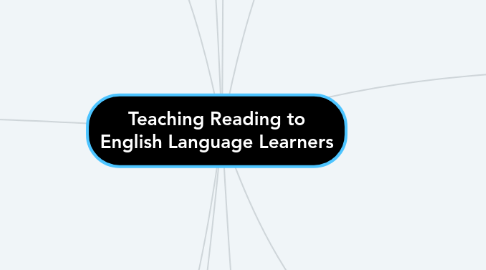
1. Chapter 3-"Rethinking Phonemic Awareness"
1.1. Phonological Awareness, Phonemic Awareness, and Cross-Language Transfer
1.1.1. Sociopsycholinguistic View
1.1.1.1. the acquisition of phonemic awareness is acquired through the use of sound and visuals in order to construct meaning.
1.1.2. Word Recognition View
1.1.2.1. the process of identifying words in which they acquire phonemic awareness skills, all done through explicit instruction.
2. Chapter 4-"Phonics"
2.1. Graphophonic Cueing Systems
2.1.1. Syntactic Cueing System
2.1.1.1. rules of what can or can not happen in the grammar rules of a language, creating great variation
2.1.1.1.1. ex: (English) The red house. v. (Spanish) La casa roja
2.1.2. Semantic Cueing System
2.1.2.1. in order to understand a word, the CLD students used his/her background knowledge and context clues that exist in a sentence in order to understand the meaning.
3. Chapter 5-"Vocabulary Development"
3.1. Approaches to Vocabulary Instruction
3.1.1. Reader-Based Instruction
3.1.1.1. word part emphazis, the way in which the parts come together, and the menaing that they create.
3.1.1.1.1. ex: prefixed, roots, suffixes
3.1.2. Interactive Language Learning
3.1.2.1. breaking down the meaning of words through interactive class/peer discussion prior to the exposure in meaning of a word.
3.1.2.1.1. ex: preteacing
3.1.3. Direct Instruction
3.1.3.1. most straight-forward teaching approach while still maintaining the most meaningful culturally inclusive instruction, usually aimed for students who lack teaching environments at home.
3.1.3.1.1. ex: building from the known in order to teach the unknown
4. Chapter 7-"Fluency in Practice"
4.1. From Surface Constructs to Deep Constructs in Fluency Development
4.1.1. Deep Constructs of Fluency
4.1.1.1. An in-depth approach to teaching in which the goal's focuses on the skill of meaningful comprehension,
4.1.2. Surface Constructs of Fluency
4.1.2.1. A very superficial teachiing approach which merely focuses on factors such as automacity, and accuracy
5. Chapter 9-"Assessment beyond the Politics of High-Stakes Tests"
5.1. Authentic Reading Assessments
5.1.1. Socio-Cultural Inclusion
5.1.1.1. When a teacher gets informed about the Student's sociocultural background, he/she might get a better understanding or idea about their performance in classroom.
5.1.2. Language as Cultural Response
5.1.2.1. When looking at CLD student's native languages as a valuable asset to their identity, the teacher creates an empowering tool for the student.
5.1.3. Academic Inclusion
5.1.3.1. Rather than setting a goal to forget about the CLD's native language in order to acquire English as a second language, the teacher may scaffold on the previous knowledge that already exists in the first language and build on that.
6. Chapter 1
6.1. Thoretical Foundations of Reading
6.1.1. The Interactive Reading Process Model
6.1.1.1. role of the reader is the one of constructor of meaning through the simultaneous use of schematic connections and decoding of letters and words.
6.1.2. The Top-Down Reading Process Model
6.1.2.1. whole-to-part model of the reading process, which involves schematic connections to text and they are used as a starting point for development of skills.
6.1.3. The Bottom-Up Reading Process Model
6.1.3.1. part-to-whole model of the reading process, skills are mastered in sequential process beginning with letter recognition and ending with schema level analysis.
7. Chapter 2-"Contextualizing Literacy Development for the CLD Student in the Grade-Level Classroom"
7.1. CLD Student Biography
7.1.1. Sociocultural Dimension
7.1.1.1. the social and cultural factors that have potential of influencing the CLD student's academic learning.
7.1.2. Academic Dimension
7.1.2.1. acknowledging the value of the CLD students native language because we know that it is a tool for students to transit the factors that make up for their identity.
7.1.3. Linguistic Dimension
7.1.3.1. Informing ourselves as educators about the prior-schooling experiences that our CLD students have acquired can be used as a tool to find the appropriate level approaches of teaching the second language
7.1.4. Cognitive Dimension
7.1.4.1. the way in which students think about information, the way in which they acquired it, and the ways in which they apply the knowledge
8. Chapter 6-"Strategies-Based Comprehension Instruction"
8.1. Reading Comprehension Strategies
8.1.1. Metacognitive Strategies
8.1.1.1. strategies that help the learner decie how to prepare and plan for effective reading and in which way to use the strategies
8.1.1.1.1. ex: Smikkimg, think aloud, check for understanding of the text, etc.
8.1.2. Cognitive Strategies
8.1.2.1. strategies that allow the reader to amnipulate mentally of physically the material being read.
8.1.2.1.1. ex: highlighting, note taking, mind mapping, etc.
8.1.3. Social-Affective Strategies
8.1.3.1. strategies that engage students in interaction to enhance comprehension of the text.
8.1.3.1.1. ex:asking critical questions, making connections to personal experience, asking for clarification, etc.
9. Chapter 8-"Implications of Culture and Language in Writing"
9.1. Interactive/Direct Approaches to Teach CLD Students to Write
9.1.1. Dictado
9.1.1.1. Commonly used strategy for acquisition of proper spelling and grammar in Mexico, consisting of the dictation of a series of words or sentences in which student's work, improve on, and get re-tested over throughout the week.
9.1.2. Beginning Writing Genres
9.1.2.1. The Language experience approach strategy to teach writing which integrates listening, speaking, reading, and writing in which the students are in charge of dictating their own stories.
9.1.3. Interactive Spelling
9.1.3.1. Through cooperative team peer tutoring, in which paired students take on the roles of tutor and tutees, and dictate words to each other as an assessment.
10. Chapter 10-"Inclusive Literacy Instruction for CLD students"
10.1. Standards, Reading Programs, & CLD Student Biography
10.1.1. Sociocultural Knowledge
10.1.1.1. Through the inclusion of multicultural resources such as books, videos, images incorporated into the classroom, we are capable of empowering our CLD student's identities.
10.1.2. Linguistic Knowledge
10.1.2.1. Through support in development of the CLD students first language the skills and progress are transferred over to the second-language.
10.1.3. Academic Knowledge
10.1.3.1. Through the process of educators getting informed about the depth of academic knowledge that the CLD student has already acquired, the teacher may use this as a foundation to build on.
10.1.4. Cognitive Knowledge
10.1.4.1. By the usage of scaffolding, building on background knowledge to use as a foundation, exposure to key vocabulary prior to readings,and detailed instruction of reader comprehension strategies.

